This article needs additional citations for verification .(January 2018) |
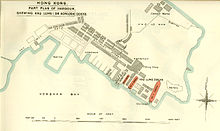


Hong Kong and Whampoa Dock was a Hong Kong dockyard, once among the largest in Asia.
This article needs additional citations for verification .(January 2018) |



Hong Kong and Whampoa Dock was a Hong Kong dockyard, once among the largest in Asia.
Founded in 1866 by Douglas Lapraik and Thomas Sutherland, [1] the Hong Kong and Whampoa Dock Company (known as Hong Kong Kowloon and Whampoa Dock Company). In 1865, it was known as Kowloon Docks and located on the west Kowloon coast between Hung Hom and Tai Wan, facing Hung Hom Bay in the Victoria Harbour. It is also known as Whampoa Dock for short. The "Whampoa" part of the name comes from the harbor located at was then known as Huangpu Island (previously transliterated as Whampoa), adjacent to the city of Guangzhou (previously transliterated as Canton), where the company owned another dockyard.
On the eve of Japanese occupation of Hong Kong, the dockyard was heavily bombarded by Japanese aircraft due to its importance, causing many casualties.
In the mid-1960s, the Hong Kong and Whampoa Dock Company was controlled by Douglas Clague through Hutchison International but he was forced to leave following financial difficulties with Hutchison International. Hutchison International was acquired by Li Ka Shing's Cheung Kong Holdings and eventually merged with Whampoa to become Hutchison Whampoa. In 1985, the dockyard land was transformed into a private housing estate, the Whampoa Garden, the second-largest private housing estate in Hong Kong, after Mei Foo Sun Chuen. The only portion of the dockyard that exists is Bulkeley Street.[ citation needed ] The dockyard is now part of the Whampoa Garden site residential complex.
The dockyard operations merged with Swire's Taikoo Dockyard on the Island to become Hongkong United Dockyards on the new territories western shore of Tsing Yi Island Wok Tai Wan.
Hong Kong and Whampoa Dock helped converted Hong Kong Tramways second and third generation tram cars built by United Electric and English Electric. These cars were eventually retired from 1924 to 1930 as the fourth-generation cars were introduced.
Other facilities:
Ships built at this yard include:
Hutchison Whampoa Limited (HWL) was an investment holding company based in Hong Kong. It was a Fortune Global 500 company and one of the largest companies listed on the Hong Kong Stock Exchange. HWL was an international corporation with a diverse array of holdings which included the world's biggest port, and telecommunication operations in 14 countries that were run under the 3 brand. Its businesses also included retail, property development and infrastructure.
Whampoa is a romanisation of 黃埔 / 黄埔, and may refer to:

Hung Hom is an area in the southeast of Kowloon Peninsula, Hong Kong. Including the area of Whampoa, Tai Wan, Hok Yuen, Lo Lung Hang and No. 12 Hill are administratively part of the Kowloon City District, with a portion west of Hung Hom Bay in the Yau Tsim Mong District. Hung Hom serves mainly residential purposes, but it is mixed with some industrial buildings in the north.

USS Seahorse (SS-304), a Balao-class submarine, was the first submarine and second ship of the United States Navy to be named for the seahorse, a small fish whose head and the fore part of its body suggest the head and neck of a horse.

Hongkong United Dockyards abbreviated to United Dockyards or HUD is a dockyard built on the site of the former Shek Wan or "Stone Bay", on Tsing Yi Island of Hong Kong.

Whampoa Garden is the largest private housing estate in Hung Hom, Kowloon, Hong Kong. It was built on the site of the former Whampoa Dockyards by Hutchison Whampoa Property. The urban design of the estate incorporates concepts inspired by the Garden city movement and was completed in 1991.
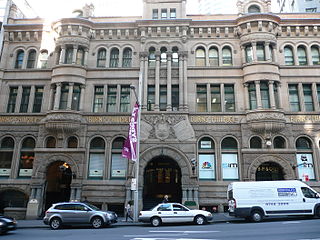
Burns Philp was a major Australian shipping line and merchant that operated in the South Pacific. When the well-populated islands around New Guinea were targeted for blackbirding in the 1880s, a new rush for labour from these islands began. James Burns and Robert Philp purchased several well-known blackbirding ships to quickly exploit the human resource in this region, and Burns Philp entered the slave trade. The company ended its involvement in blackbirding in 1886. In later years the company was a major player in the food manufacturing business. Since its delisting from the Australian Securities Exchange in December 2006 and the subsequent sale of its assets, the company has mainly become a cashed up shell company. It is wholly owned by Graeme Hart's Rank Group.

A hell ship is a ship with extremely inhumane living conditions or with a reputation for cruelty among the crew. It now generally refers to the ships used by the Imperial Japanese Navy and Imperial Japanese Army to transport Allied prisoners of war (POWs) and rōmusha out of the Philippines, the Dutch East Indies, Hong Kong and Singapore in World War II. These POWs were taken to the Japanese Islands, Formosa, Manchukuo, Korea, the Moluccas, Sumatra, Burma, or Siam to be used as forced labor.
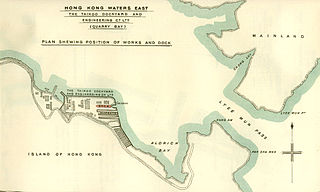
Taikoo Dockyard and Engineering Company was a dockyard in what is now Taikoo Shing, MTR Tai Koo station and part of Taikoo Place of Quarry Bay on the Hong Kong Island in Hong Kong.
Cosmopolitan Dock was one of the major dockyards in Hong Kong.

Asama Maru was a Japanese ocean liner owned by Nippon Yusen Kaisha (NYK). The ship was built in 1927–1929 by Mitsubishi Shipbuilding & Engineering Co. at Nagasaki, Japan. The vessel was named after an important Shinto shrine.

The Chichibu Maru (秩父丸) was a Japanese passenger ship which, renamed Kamakura Maru, was sunk during World War II, killing 2,035 soldiers and civilians on board.
Gyōkū Maru (暁空丸) was a 6,854 GRT cargo ship that was laid down 6 December, 1941 as Empire Dragon by Hong Kong & Whampoa Dock Co Ltd, Hong Kong for the Ministry of War Transport (MoWT). She was seized by the Japanese on 26 December, 1941 with the fall of Hong Kong and completed as Gyōkū Maru in August, 1943, serving until September 1944 when she was torpedoed and sunk by USS Thresher in the Yellow Sea.
The SS China Maru was a 5,870-gross register ton cargo ship built by Kawasaki Dockyard Company, Kobe, for Kawasaki Kisen KK in 1920.
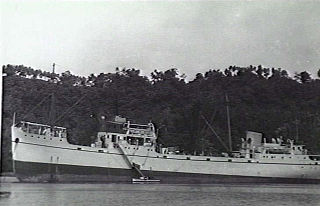
The MV Tulagi was a merchant ship built in 1939 and operated by the Burns Philp shipping line to carry cargo between the Pacific Islands and Australian ports. With the outbreak of World War II the Tulagi formed part of the Allied merchant navy fleet supplying the war effort throughout the Pacific and Indian Ocean theatres.
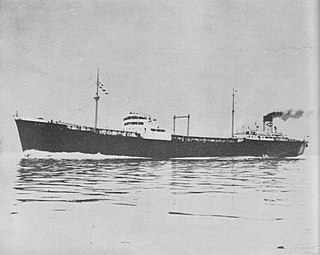
Kuroshio Maru was a tanker that was built in 1938 for Japanese owners. She was chartered by the Imperial Japanese Navy and Imperial Japanese Army during World War II: the ship was sunk in January 1945 at Takao, Formosa by American aircraft. Salvaged in 1946, she was allocated as a war prize to China and renamed Yung Hao, but was forced to remain at Hong Kong by the British. She was requisitioned by the Admiralty during the Korean War and allocated to the Royal Fleet Auxiliary. She was to have been named RFA Surf Pilot but due to her poor condition she did not serve in the Royal Fleet Auxiliary. She served as Surf Pilot, a tender to HMS Terror until 1958 and was subsequently scuttled off Pulau Aur, Malaya in 1960.
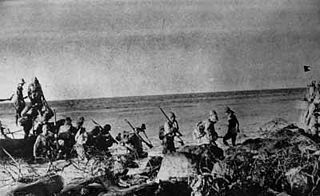
Kaimei Maru was a Japanese troop transport ship operated by the Imperial Japanese Army during World War II which was sunk off Honshu on 4 September 1942 by the American submarine USS Guardfish. The ship was a British WWI Type B military cargo ship built by the Hong Kong and Whampoa Dock Company.

SS Fatshan was a passenger ferry steamer which sank in stormy seas off Lantau Island during Typhoon Rose resulting in the loss of 88 lives.
The USS YAG-3 was a miscellaneous auxiliary service craft of the United States Navy that served during World War II.
The USS YAG-4 was a miscellaneous auxiliary service craft of the United States Navy that served during World War II.